Springtails are animals ranging in size from approximately 0.12 mm to 17 mm. They have a head, a chest consisting of three segments and an abdomen that includes six. The head carries antennas, the thorax has three pairs of legs and the abdomen has a jumping organ called furca and other organs with specific functions.
This photo montage1 on which I respect the proportions, highlights the differences in size between the smallest species that I was given to photograph, Neelus murinus (Neelipleone) whose size is close to 0.6 mm, and the largest, Orchesella villosa (Entomobryomorph) whose average size is about 5 mm.

All springtails, regardless of their size, have the same internal organs as illustrated by the anatomical section of an Arthropleleone2:
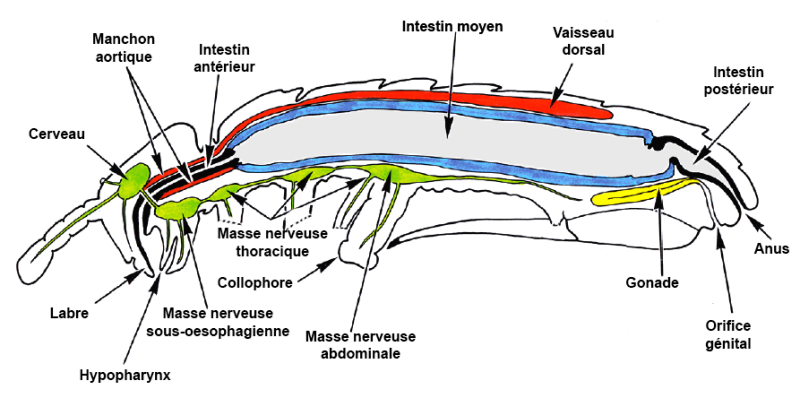
Digestive system :
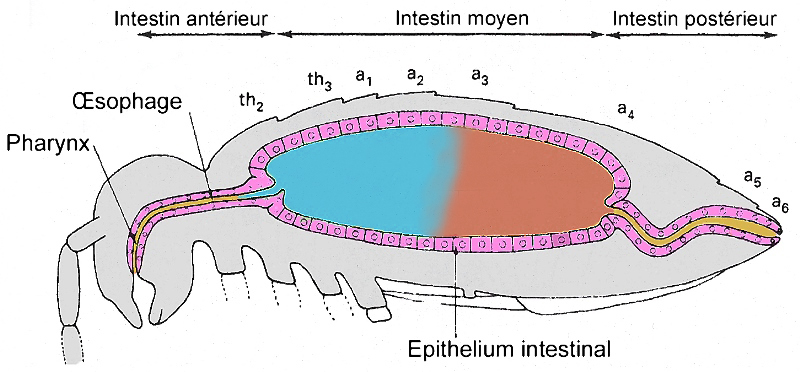 Springtails have a digestive system consisting of an intestine divided into three distinct parts which allow the digestion and evacuation of food, respectively, as shown in the sketch below3 representing the section of an Arthropleone springtail. In its mouth, springtail has salivary glands whose function is to secrete enzymes that will be mixed with food in the oral cavity. The anterior intestine begins after the pharynx and is prolonged by a gullet that delivers food to the midgut. the latter is presented as a large pocket surrounded by a network of muscles arranged in a circular and longitudinal manner. The contractions of this muscular network make it possible to knead the food and to evacuate it to the posterior intestine whose junction with the middle intestine (pyloric zone) is endowed with a sphincter. The interior of the midgut is lined with digestive cells that secrete enzymes capable of absorbing the products of digestion. The level of acidity (pH) that reigns in the intestinal pocket is maintained at an optimal value to allow these enzymes to fulfill their role. The pH measured in the central and posterior area of ??the intestine (red) is close to pH6, which corresponds to a slightly acidic medium (uncommon with human gastric juice, which with a pH2 is 10,000 times more acidic). The anterior part (blue) has a pH8 which places it in a slightly alkaline value (comparable to the pH of the sea water). Some species of springtails such as Pogonognathellus flavescens secrete cellulase which is an enzyme capable of digesting cellulose which also allows them to play an essential role in the transformation of organic matter into humus through their droppings which take place under form small fecal balls. The latter take shape in the rectum after the water contained at the exit of the midgut has been absorbed by the cells of the posterior intestine. The analysis of the midgut content reveals the presence of bacteria and fungi, which in themselves are an important part of springtail feeding. Researchers also believe that the midgut may contain other symbiotic living bacteria capable of making certain enzymes that springtail does not produce naturally. Part of the ingested mushrooms resist the digestive process and because of this, their excrement is an important vector of dissemination in soils.
Springtails have a digestive system consisting of an intestine divided into three distinct parts which allow the digestion and evacuation of food, respectively, as shown in the sketch below3 representing the section of an Arthropleone springtail. In its mouth, springtail has salivary glands whose function is to secrete enzymes that will be mixed with food in the oral cavity. The anterior intestine begins after the pharynx and is prolonged by a gullet that delivers food to the midgut. the latter is presented as a large pocket surrounded by a network of muscles arranged in a circular and longitudinal manner. The contractions of this muscular network make it possible to knead the food and to evacuate it to the posterior intestine whose junction with the middle intestine (pyloric zone) is endowed with a sphincter. The interior of the midgut is lined with digestive cells that secrete enzymes capable of absorbing the products of digestion. The level of acidity (pH) that reigns in the intestinal pocket is maintained at an optimal value to allow these enzymes to fulfill their role. The pH measured in the central and posterior area of ??the intestine (red) is close to pH6, which corresponds to a slightly acidic medium (uncommon with human gastric juice, which with a pH2 is 10,000 times more acidic). The anterior part (blue) has a pH8 which places it in a slightly alkaline value (comparable to the pH of the sea water). Some species of springtails such as Pogonognathellus flavescens secrete cellulase which is an enzyme capable of digesting cellulose which also allows them to play an essential role in the transformation of organic matter into humus through their droppings which take place under form small fecal balls. The latter take shape in the rectum after the water contained at the exit of the midgut has been absorbed by the cells of the posterior intestine. The analysis of the midgut content reveals the presence of bacteria and fungi, which in themselves are an important part of springtail feeding. Researchers also believe that the midgut may contain other symbiotic living bacteria capable of making certain enzymes that springtail does not produce naturally. Part of the ingested mushrooms resist the digestive process and because of this, their excrement is an important vector of dissemination in soils.
Note: The digestive system is an extension of the outer cuticle. As such it is also subject to successive moults effected by springtail.
Respiratory process :
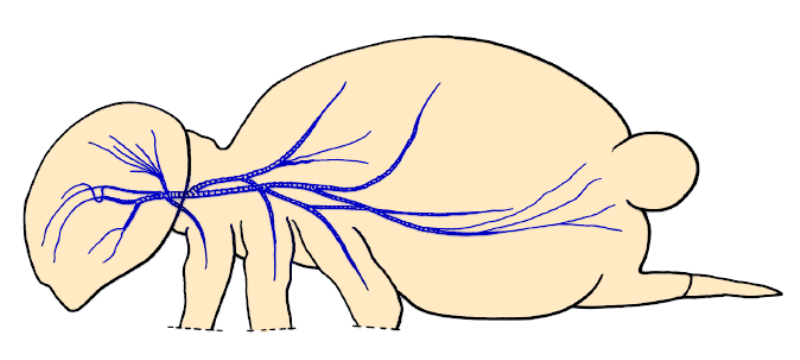
Rather than talking about breathing, the term gaseous exchange should be used. The proportion between the relatively small size of springtail and its body surface including the wet surface of the ventral tube plays in favor of this respiratory mode. In many species, the cuticle offers no opposition to gaseous exchanges with the outside. The need for air varies according to the different families of springtails, directly correlated with their level of activity.
For example, the needs are minimal when they moult or when they are hungry or when they rest during the summer or freezing periods. The hygrometry and the temperature of the ambient air also exert a significant influence on the necessary volumes of exchanges, the hotter the more they consume. As a general rule, springtails living above the ground (epededaphic) have a higher oxygen consumption than those living in the soil (euedaphic). Symphypleones that evolve in epededaphic environments actually need more oxygen because they have to travel more distances to find adapted foods. Especially since their exposure in the open air submits them to a greater number of predators than they can cope by running away, which adds to their oxygen consumption.
The nervous system :
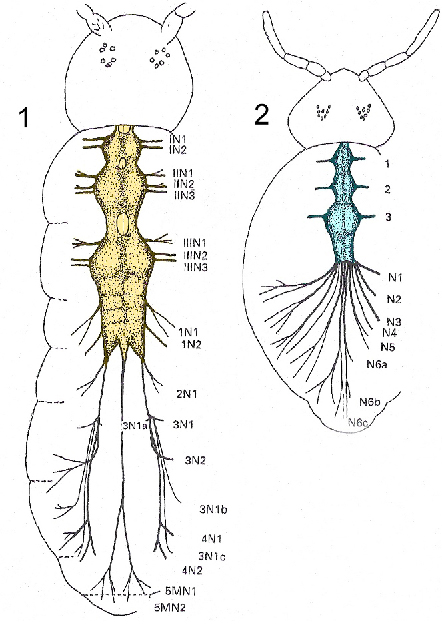 The diagram below5 shows the thoracic and abdominal nervous systems of a Tomceridae (Arthropleone) and a Sminthuridae (Symphypleone). Each consists of an abdominal ganglion connected to three thoracic ganglia that extend to the first thoracic segment from which the connection to the brain in the head is made.
The diagram below5 shows the thoracic and abdominal nervous systems of a Tomceridae (Arthropleone) and a Sminthuridae (Symphypleone). Each consists of an abdominal ganglion connected to three thoracic ganglia that extend to the first thoracic segment from which the connection to the brain in the head is made.
The size of springtails considerably reduces the prospective field of study of the nervous system. It is almost impossible to measure nerve impulses in order to establish, as for larger animal species, significant electroencephalograms. The methods used exploit two types of data:
- Data of behavioral nature, through the study of reactions to various stimuli. In this case we use the sensory perception of the animal.
- Observational physiological data, through the analysis of the nature and typology of cells present on different parts of the body.
In research programs, the spectrum of stimulations on springtails sweeps across the areas of taste, smell, light sensitivity, touch, sound vibrations, atmospheric pressure, temperature and humidity as well as the concentration of air in carbon monoxide.
Moulting :
In springtails, moult6 is a process of renewal of its external envelope constituted by its cuticle (skin), but which also includes the sensilla, hair, external sensory sensors, trachea and anterior and posterior areas of the intestine. The moulting is materialized by a succession of steps: (see diagram below)7.
In the first place, springtails stops and stops feeding. The cells of his hypoderm then secrete an exuvial fluid (orange on the diagram) between the old and the new cuticle (fig.2). This liquid contains enzymes capable of digesting the endocuticle (beige) of the future exuvia which will gradually become detached. The products of this digestion will be largely reused during the cuticular synthesis which will allow these same cells to produce a new cuticle (fig.3).
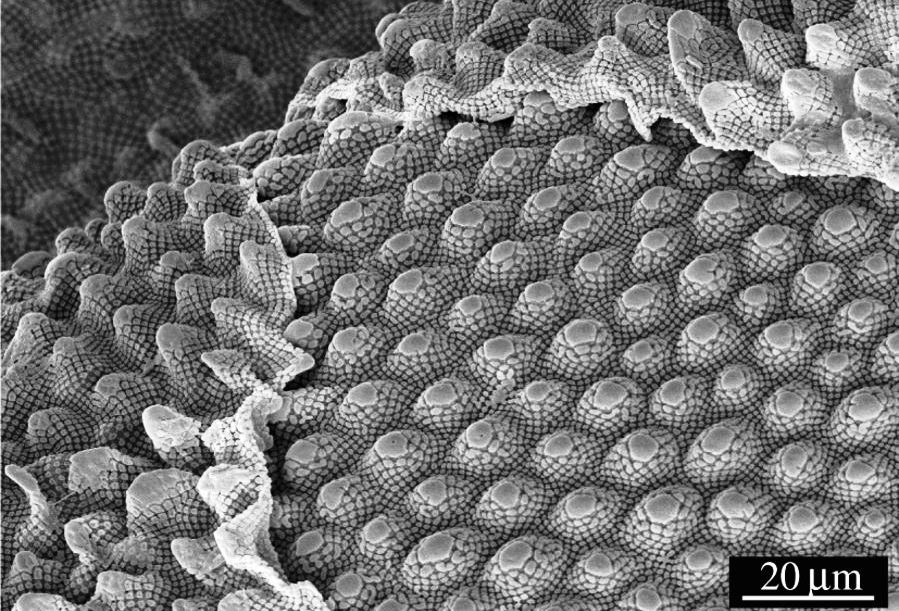 The process of formation of these new tissues begins first with the epicuticle (green) then the exocuticle (purple) and the endocuticle (beige). As a result, springtail can be released from the old cuticle reduced by more than 80% by the action of enzymes. This phenomenon is called exuvation. The image8 shows the exuviae of a Tetrodontophora bielanensis that splits to give way to the new cuticle.
The process of formation of these new tissues begins first with the epicuticle (green) then the exocuticle (purple) and the endocuticle (beige). As a result, springtail can be released from the old cuticle reduced by more than 80% by the action of enzymes. This phenomenon is called exuvation. The image8 shows the exuviae of a Tetrodontophora bielanensis that splits to give way to the new cuticle.
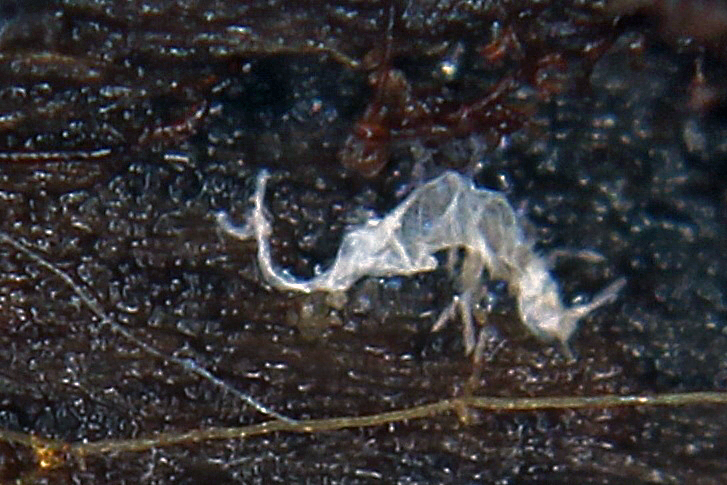 The growth of springtails with an average life of one year (although in the laboratory 67 months longevity) has been achieved without metamorphosis. It is ensured by a succession of moults in number and frequency that vary according to the species, the environment in which it evolves and certain external conditions such as temperature. For example, to reach sexual maturity, Mesaphorura krausberi can undergo 5 to 8 moults, while Orchesella cincta in sudden from 11 to 13. Beyond the stage of the sexual maturity, moults continue and can, for some species, approach or exceed the number of forty. Left exuvia of a collembolla1 on a dead leaf. The duration of a complete moult varies according to the age of collembola, in young subjects Heteromurus nitidis (below) 1 it lasts from 3 to 4 days (at 20 ° C) whereas in adults of the same species it spread over 8 to 10 days. Throughout this process, springtail is exposed because it can not escape predators and can cause many injuries as long as its new cuticle is not tough enough.
The growth of springtails with an average life of one year (although in the laboratory 67 months longevity) has been achieved without metamorphosis. It is ensured by a succession of moults in number and frequency that vary according to the species, the environment in which it evolves and certain external conditions such as temperature. For example, to reach sexual maturity, Mesaphorura krausberi can undergo 5 to 8 moults, while Orchesella cincta in sudden from 11 to 13. Beyond the stage of the sexual maturity, moults continue and can, for some species, approach or exceed the number of forty. Left exuvia of a collembolla1 on a dead leaf. The duration of a complete moult varies according to the age of collembola, in young subjects Heteromurus nitidis (below) 1 it lasts from 3 to 4 days (at 20 ° C) whereas in adults of the same species it spread over 8 to 10 days. Throughout this process, springtail is exposed because it can not escape predators and can cause many injuries as long as its new cuticle is not tough enough.
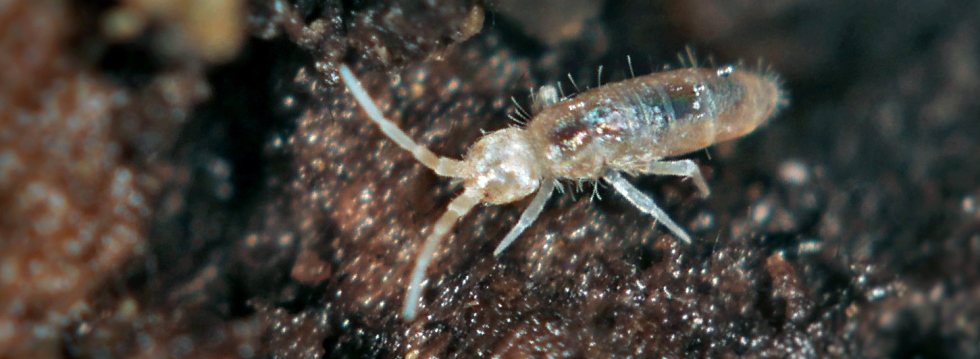
1 Images by Philippe Garcelon
2 Sketches taken from "Le petit collembole illustré" - Jean-Marc Thibaud. Arvernsis (2010).
3 "Biology of the springtails" by Stephen P. Hopkin - oxford university press - 1997.
4 Adaptation of a sketch of Jean-Marie Betsch - 1977
5 Adaptation of sketches by U. Brauner "Zoologische jarhbucker fur anatomy" - 1981.
6 Information from an article with extracts from "Insects and Man" - Michel Lamy -Albin Michel 1997
7 Diagram reconstructed from a plate by H.Boué and R.Chanton -1958.
8 "The multi-layered protective cuticle of collembola" - J.Nickerl / M.Tsurka / R.Hensel / C.Neinhuis / C.Werner - Journal of the Royal Society -2014